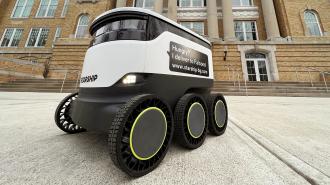A fleet of autonomous delivery robots is now rolling around a college campus on airless tires, which never go flat and could help address a massive environmental problem.
Airless tires: Tires made from air-filled rubber are the norm because they can both grip the road and provide a smooth ride. However, the downside to these tires is that they’re also prone to punctures, either from running over something they shouldn’t have or simple wear and tear.
In 2017, Goodyear, one of the biggest tire manufacturers in the world, announced the development of airless tires (also called “non-pneumatic tires,” or NPTs) that wouldn’t be prone to punctures.
Like traditional tires, Goodyear’s airless tires have a rubber exterior, ensuring a good grip, but the standard air-filled interior is replaced by a system of spokes strong enough to maintain the tire’s shape, but flexible enough to provide some give, like air.
“We need tires that are reliable and keep our robots on the move around the clock and around the globe.”
Siim Viilup
The challenge: If a traditional vehicle experiences a flat, the driver can replace the damaged tire with a spare and be on their way.
However, San Francisco’s Starship Technologies operates more than 1,000 delivery robots that operate without drivers. That means a flat tire puts the vehicle out of commission until a person can reach the robot to change it — delaying deliveries to customers.
“To make sure we can keep up with the growing demand for our services, we need tires that are reliable and keep our robots on the move around the clock and around the globe,” Siim Viilup, Starship’s mechanical engineering manager, said in a press release.
The request: Starship recently asked Goodyear if it could design a smaller version of its airless tires for the company’s delivery robots, and the tire giant has now delivered.
“The micro delivery space presents a different set of needs as it relates to the tire,” said Michael Rachita, Goodyear’s senior program manager for non-pneumatic tires, “and our NPT technology is ideal to meet those needs to help enable a maintenance-free and long-lasting experience.”
Goodyear’s airless tires are now being tested on a small fleet of Starship delivery robots on the Bowling Green State University campus in Ohio. If the trial goes well, they may roll out nationwide.
The big picture: Goodyear isn’t the only manufacturer developing airless tires — Michelin recently unveiled a design it hopes to offer to drivers by 2024, and South Korea’s Hankook just debuted its latest airless tire concept.
Clearly, the industry is interested in moving away from the standard tire design, but airless tires still have some design problems that might prevent the transition.
They’re less versatile, for example — you can adjust the air pressure in a standard tire to get a smoother ride — and while they aren’t going to go flat, debris can become lodged in their spokes, causing other types of damage.
However, if airless tires do become the standard, people might not need to replace their tires as frequently — and that could help address the problem of mountains of discarded tires currently piling up in landfills and floating in waterways.
We’d love to hear from you! If you have a comment about this article or if you have a tip for a future Freethink story, please email us at tips@freethink.com.
